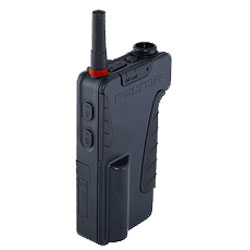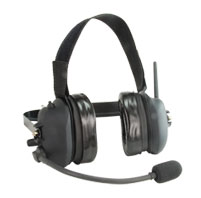TRBOnet is a professional grade application especially developed for Dispatch centers that monitor large amounts of traffic. It supports digital as well as analog channels that could be helpful for clients during their migration period. Also makes response during emergency situations quick and effective, and can be used to link multiple agencies or departments at the touch of a button by the dispatcher.
What will TRBOnet do for you
TRBOnet will enable you to monitor audio, data, and the locations of your assets, provide record management and ability to review events that have taken place.
- Asset tracking
- Unit safety
- Unit monitoring
- Telemetry and emergency triggers
- Seamless system integration
- Instant Notification
- Integration with existing systems
- Reporting capabilities
- Mixed channels (digital/analog) supporting
TRBOnet uses capacities of a digital standard DMR and IP protocol embodied in radio stations MOTOTRBO™ Motorola. At the same time TRBOnet solution expands standard capacities of MOTOTRBO™ radio stations, in the first place it expands the capacities connected with feature that permits carrying out voice calls along with data transfer.
TRBOnet solution is developed for creation of system of communication, management and monitoring for different organizations or enterprises. As example of its application we can suggest organization of public safety, transport enterprises, municipal services, emergency services, encashment services where besides usual voice radio communication there is necessity of control and detection of location of movable objects and their management, sending of text messages and some additional features (for example, feature ‛panic button‛), digital data transfer.
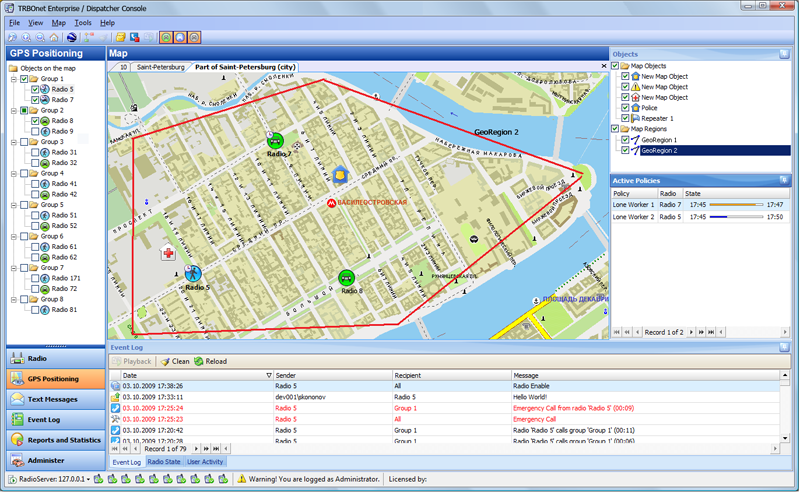
Main advantages of TRBOnet are its scalability and reliability. At having created not very big radio communication network you can increase it without any limits both in quantity of users and territory of use. In the system there is no ‛central mind‛, and in case of failure of one TRBOnet component the whole system will continue to function.
Complex implementation of TRBOnet and MOTOTRBO™ increases considerably an efficiency of production and business processes due to allocation of new radio communication services and permits to decrease expenses for radio networks organization.
The main component of the system is 'radioserver' that is program software installed in a computer which is digital fixed radio station Motorola MOTOTRBO™ connected to, for ensuring connection with mobile users through a radio channel.
At turning on the power user radio station MOTOTRBO™ sends an authorization enquiry to the radioserver and registers in the network. For registered users in the TRBOnet network for a dispatcher main features of the system become available; those are individual and group calls, sending of text messages, use of built-in telemetry of MOTOTRBO™, GPS-monitoring of users, conversation recording etc.
In the data base of the radioserver there is information about all registered user radio stations. The highest number of users working with this radioserver is limited with the radio channel capacity only.
There can be unlimited number of radioservers, they can be situated in any point of the world, Internet access is needed only. Unlimited number of dispatchers can connect to any radioserver through computer networks.
A dispatcher gets a possibility to call any available user of the TRBOnet network from the dispatcher’s work place.
TRBOnet uses GPS-receiver and digital maps of different types built-in radio stations MOTOTRBO™ to monitor fleet of movable objects and their management. At the same time a dispatcher can get on-line information about current location of a police car, an ambulance car or a car transporting covetable items or dangerous items in an on-line mode at a digital map, and in case of need communicate with the car through radio communication or transfer to the user different data in digital format.
TRBOnet Architecture
TRBOnet is based on classic client-server archutecture. The main advantage is the flexability: the software is the best for distributed systems, but it also can be installed on a single computer.
Click to expand the picture

Direct IP Connect to MOTOTRBO repeaters
Since the version 2.8 TRBOnet™ Enterprise is able to operate with MOTOTRBO repeaters directly over IP! Master Radios are not longer required!
TRBOnet RadioServer connects to repeaters using UDP protocal and receives/transmits data and digital audio (native AMBE+2)
Supported Systems:
- Single MOTOTRBO repeaters in digital mode and IPSC enabled
- IP SITE CONNECT system
- Capacity Plus
Benefits:
- All voice and data are recorded, including private calls and text messages between units
- Very easy to install and configure
- Less expensive
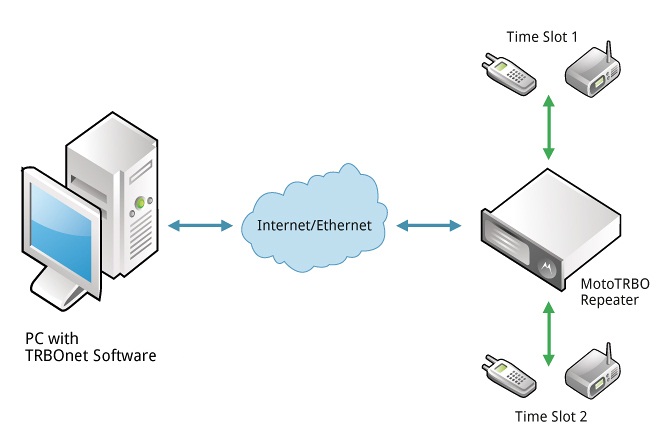
TRBOnet Enterprise: Advanced Dispatch System
The powerful solution provides VoIP software-base control center for MOTOTRBO radio stations and is built in the layer between transport and network level protocols (UPD and TCP/IP). TRBOnet Enterprise supports all features of MOTOTRBO radio stations (Capacity Plus, GPS Positioning, Text Messaging, ARS, and Telemetry) and offers you a number of specific options such as Voice Recording, Geo-Fencing, Lone Worker operation, Intercom, Scheduler for Text Messages, Unit Activity Monitor, Email Gateway, etc.
The simplest dispatch system supported by TRBOnet Enterprise consists of one RadioServer which operates as a gate between radio stations and IP network, and an unlimited number of dispatcher consoles. All Dispatchers are provided with a simple and easy-to-use interface which allows them to service dozens of radio stations and radio groups.
To connect to radio networks, TRBOnet Enterprise uses one or more MOTOTRBO radio stations. Dispatchers connect to the RadioServer via local wire or wireless networks or Internet and use IP protocol. TRBOnet Enterprise supports distributed dispatch systems where Dispatchers from around the globe can connect to a central RadioServer. For instance, Dispatchers from Miami and Tokyo can connect to a RadioServer installed in London to check positions of mobile objects they are in charge of, call subscribers and report to fellow Dispatchers.
TRBOnet Enterprise supports radio networks where operate both analog (including MDC) and digital subscribers. At that, calling subscribers’ ID (callsing) is always visible to Dispatchers.
All radio traffic is registered within the dispatch system. Dispatchers can replay audio records and, if necessary, download separate audio files to their PC for reporting.
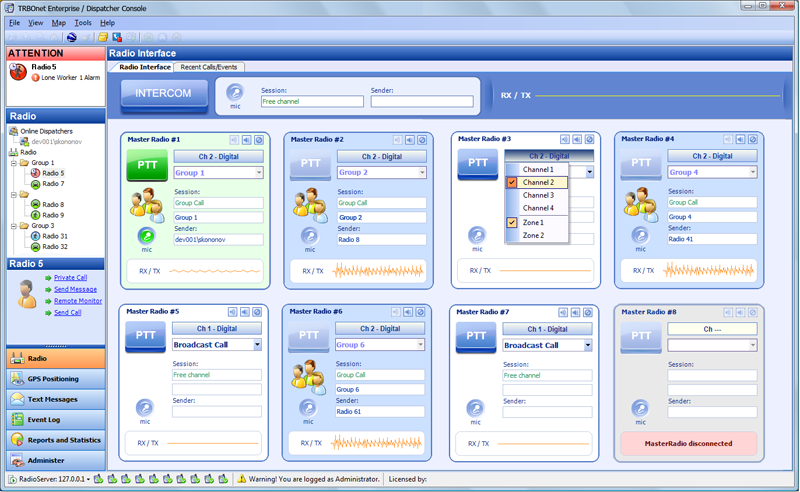
More features are available to digital subscribers.
Dispatch system supports subscriber status control. Subscribers’ status is reflected in dispatcher consoles. When subscribers become online, their Dispatchers receive notifications (subscriber’s status always displays in his or her Dispatcher’s console). After that, subscriber’s radio station regularly reports its GPS coordinates to the RadioServer. Appropriate Dispatchers can review station movements on various electronic maps and set a tracking mode.
GeoFencing feature implies control over crossings of set regions. TRBOnet Enterprise allows you to appoint regions to subscribers and control their crossing the borders, which can be useful for operation in classified units or restricted areas. Both subscriber and Dispatcher receive notifications when the subscriber violates appointed region, and the breach is registered within the dispatch system.
Dispatchers receive all incoming text messages from subscribers and can send text to a specific subscriber or group of subscribers. Dispatch system can re-transmit the received messages to specified email addresses.
The access control for Dispatchers is fully supported. You can set different access permissions for each Dispatcher. For instance, you can designate a Dispatcher for a several groups of subscribers, and then information on other radio stations for the subscriber will be unavailable. Permissions to add, modify, or remove subscribers from the dispatch system as well as changes to RadioServer channel, etc. can also be limited.
Intercom feature provides Dispatchers with a communication option apart from radio network, which allows minimizing radio load.
TRBOnet™ Features
Voice Dispatch
The VoIP communications technology offers the possibility of transmitting voice via IP networks. Thus, a remote dispatcher having access to the radioserver via IP network can communicate with radio network subscribers and other dispatchers from any place of the world.
Voice Recording
TRBOnet provides recording of all conversations between dispatchers and subscribers, including private calls and text messages between subscribers (direct IP connect to repeaters required). The conversations are stored as audio files on the hard disk and are logged in the event log with date and time indication and playback capability.
TX Passive
The TX Passive function allows for delaying the transmission in case the line is busy. The dispatcher records a message and queues it. TRBOnet RadioServer transmits the message as soon as the line gets free.
Intercom
The Intercom function allows the dispatchers communicate among themselves separately from the main line, thus, lessening the load of the line.
Telephone Interconnect
The telephone Interconnect function allows making calls from radios to telephones and from telephones to radios. A dispatcher can also make calls from the Dispatcher Console.
CrossPatch
The CrossPatch enables dispatchers to patch talk groups, channels, sites and systems together to enable seemless comunication between all radio users of TRBOnet, regardless of frequency or if the radios are operating in Analog, Digital, IP site connect or Capacity plus.
Emergency
The Emergency call is activated by the emergency button on a Motorola radio. When a subscriber presses the emergency button, the alarm mode is activated and the dispatcher gets the alarm message. All the calls from this subscriber become broadcast and the system starts the monitoring of the subscriber. The system also generates alarm signal after one of the following events:
- Lone Worker Policy
- Geofencing Policy
- Speed Policy
GPS Positioning
The MOTOTRBO integrated GPS allows for indication of subscribers’ location and routes on map. Vector and raster maps are supported (i.e. Google Earth, MapPoint, MapLib, etc).
Indoor Positioning
TRBOnet™ InDoor is a software and hardware system that allows positioning and control of digital MOTOTRBO subscribers indoors where GPS satellite navigation system signals are unavailable.
Geofencing and Speed Control Policies
The Geofencing function lets the dispatcher limit the movement of subscribers. The dispatcher can add regions on the map and make rules for entering or leaving a region. For example, when a subscriber leaves a region, the system sends him/her a message and generates an alarm signal for the dispatcher.
Messages (Predefined messages, Scheduled Text messages, Text passive)
Both dispatchers and subscribers can send messages. The Predefined messages function allows for sending template messages. The Scheduled Text messages function implements the possibility to send messages in an exact interval or in time set by the dispatcher. The Text passive function is used in situations when a subscriber is offline. If a message has been sent it will be delivered when the subscriber is online.
Telemetry
TRBOnet uses the data from telemetry sensors and buttons. For example, when a telemetry button on subscriber’s radio is pressed the dispatcher gets the message about the telemetry. The dispatcher can set the parameters for telemetry.
Lone Worker
The Lone Worker policy lets the dispatcher set a time interval in which the communication with a subscriber is expected. For example, if a lone worker hasn’t called the dispatcher for 15 minutes, he/she gets a message and the dispatcher gets an alarm signal.
User Activity
The User Activity function lets the dispatcher make lists subscribers can be assigned to due to their activity. For example, if a subscriber sends a message “On duty” or presses an exact preset telemetry button this subscriber gets assigned to the “On duty” list in the Remote Dispatcher Console. The dispatcher can also assign subscribers to lists manually.
Stun Kill Passive
If the dispatcher gives a command to kill a radio which is offline TRBOnet can delay killing this radio. As soon as the radio is online the server kills it.
Radio Allocation
An exact radio can be now assigned in the system to an exact employee registered in the system. This can be really useful for situations with shift workers. All the radios are disabled and an employee will need to enter username and password to take a radio or return it. When the radio is taken it gets enabled and assigned to this worker in the system. When the radio is returned it’s no more assigned to the employee and it gets disabled again.
